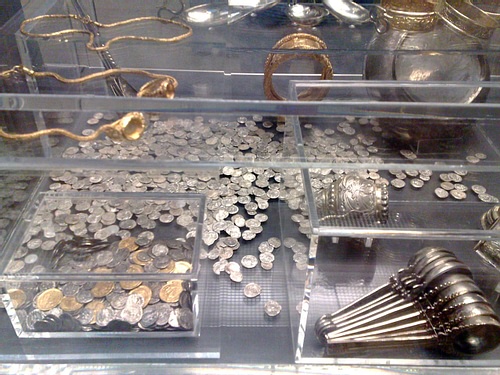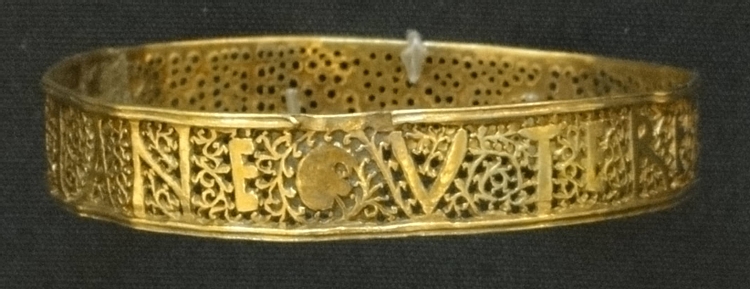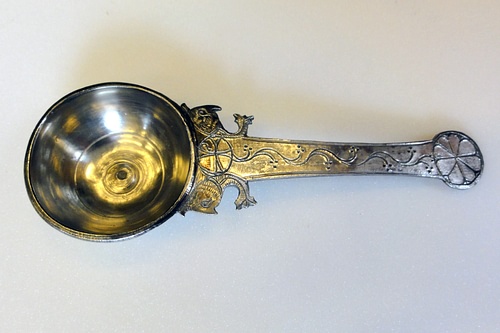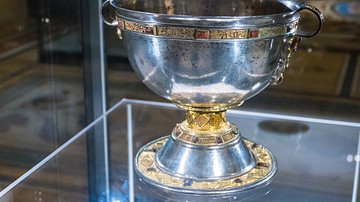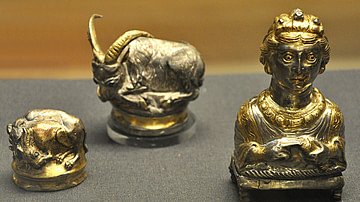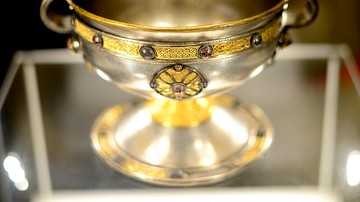The Hoxne Hoard is the largest cache of late Roman gold found anywhere in the Roman Empire. Discovered by a metal detectorist in Suffolk, in the east of England in 1992 CE, the incredible collection contains 14,865 late-4th and early-5th century CE Roman gold, silver and bronze coins, and 200 items of silver tableware and gold jewelery. The hoard amounts to a total of 7.7lb of gold and 52.4 lb of silver, and its current value is estimated at around $4.3 million. As the finder reported his discovery immediately, the cache was professionally excavated by archaeologists and conserved soon afterward so the vital context of the objects and their condition were preserved. Thanks to the coins in the hoard, we know that the items were deposited in the early-5th century CE, right at the end of the Roman occupation of Britain, which tells us a great deal about an important period in the history of the country when Roman rule was breaking down and a new age was approaching.
The Discovery
On November 16, 1992 CE, retired gardener and amateur metal detectorist Eric Lawes was scanning a field southwest of the village of Hoxne in Suffolk, England, on the lookout for a hammer which the local tenant farmer Peter Whatling had lost. Whilst searching for the hammer Lawes stumbled upon a cache of metal objects including gold chains, silver spoons and coins, some of which he dug out and packed into two carrier bags, before notifying Whatling of his spectacular find. Lawes and Whatling decided to report the discovery to the landowners, Suffolk County Council, who due to the importance of the finds, promptly organized an excavation of the site. The excavation, undertaken by Suffolk County Council Archaeology Service (SCCAS), took place the next day in secret in case the location of the hoard became known and the site looted.
Somehow, though, the story got out and on November 19 the British tabloid newspaper The Sun splashed the story across its front page along with a picture of Lawes and his metal detector and a claim that the treasure was worth £10 million. In characteristically obtuse fashion the paper also announced the prize of a metal detector to anyone who could answer the question 'who built Hadrian's Wall? Hadrian, Barretts or Wimpey?'. Meanwhile the excavated treasure from Hoxne, along with Peter Whatling's missing hammer, was taken to the British Museum in London. The unwanted publicity surrounding the find forced the British Museum to hold a press conference on November 20 announcing the discovery, which served to dampen the interest of the newspapers and permitted the curators at the museum to begin to categorize and clean the artifacts from the hoard. Further excavations in and around the findspot took place in September 1993, and also in 1994 due to illegal metal detecting around the site.
On September 3, 1993, a Coroner's inquest declared the Hoxne Hoard a treasure trove, in other words, the treasure was deemed to be of unknown ownership and to have been hidden with the intention of being recovered later. In November the Treasure Trove Reviewing Committee valued the hoard at £1.75 million (today £2.66 million or $4.3 million), which was paid to Eric Lawes as finder of the treasure. Lawes generously shared his reward with farmer Peter Whatling (which it is now a legal requirement to do). The Hoxne Hoard is now in the British Museum and the most important items are on display in a perspex reconstruction of the oak chest and inner boxes in which they were originally deposited.
The excavations at Hoxne found that the hoard had been contained inside a rectilinear feature, interpreted as being the decayed remains of a wooden chest that once held the objects. Other fragments recovered by the archaeologists, including box fittings such as hinges and locks, showed that the finds had been carefully organized into separate wooden boxes and fabric containers inside the larger oak chest. Such meticulous packing was one of the reasons why the objects were so well preserved when recovered. Archaeologists also uncovered an undated post hole, which may once have held a wooden post which served as a marker for the burial spot of the hoard.
A Description of the Hoard
Coins
The fabulously rich contents of the Hoxne Hoard include 569 gold coins,14,191 silver coins and 24 bronze coins. The gold coins (all solidi of about 4.5 grams of gold per coin) date to the reigns of eight different emperors between Valentinian I (reigned 364–75 CE) and Honorius (reigned 395–423 CE). Most of the coins in the hoard were silver siliquae (small, thin, Roman silver coins produced from 4th century CE onwards) of which there were a staggering 14,212. There were also 60 silver miliarenses (large silver coins introduced by Constantine I) and 24 bronze nummi (low value coins).
The coins from the Hoxne Hoard provide extremely helpful dating evidence for its deposition, the oldest coin in the collection is a well-worn miliarensis of Constantine II (Roman Emperor from 337 - 340 CE) and the latest two siliquae of the usurper Constantine III (reigned 407-8 CE). Thus the hoard must have been buried some time after 407-408 CE, and although we do not know how long existing coins remained in circulation it is unlikely to have been for more than perhaps 30 years, giving a probable date for the deposit of the hoard of not later than 450 CE. Just as important for giving us information about the Hoxne Hoard are the mint marks stamped on many of the coins, which identify where in the Roman Empire they were minted. 14 different mints are represented in the Hoxne Hoard :Trier, Arles and Lyon (in Gaul - modern France), Aquileia, Milan, Ravenna, and Rome (Italy); Siscia (modern Croatia), Sirmium (modern Serbia), Thessaloniki (Greece), Constantinople, Nicomedia, Cyzicus, and Antioch (modern Turkey).
Jewelry
The hoard contains 29 pieces of stunning gold jewelry: a gold body chain, six chain necklaces, three finger rings and 19 bracelets. One of the bracelets bears the inscription, VTERE FELIX DOMINA IVLIANE ("Use [this] happily lady Juliane"), which obviously indicates the name of the owner Juliane. The body chain from the hoard is a fascinatingly rare object, which would have been passed over the shoulders and under the arms of the wearer, to be fixed in place by two clasps. There are two decorative clasps where the chains join, on the front one there is an amethyst surrounded by four garnets and four empty settings which once probably held pearls (which have since decayed), and on the back a gold coin of Emperor Gratian (reigned 375-383 CE) set into a gold frame. The small size of the Hoxne body chain suggest it would only fit a very slim young woman or an adolescent girl. Interestingly, the gold frame of the coin was a reused pendant, perhaps a century old when incorporated into the elaborate body chain, suggesting a family heirloom.
Silverware
The collection of magnificent silver objects from the hoard consist of 78 exquisitely crafted spoons, 20 gilded and decorated ladles, four extremely rare pepper-pots, five bowls, two vases, nine toilet implements (toothpicks and ear-cleaners), and two padlocks from now decayed small wooden caskets. A number of the spoons are decorated with a Christian monogram cross or Chi-Rho symbol, and one is engraved with the common Christian phrase, VIVAS IN DEO ("May you live in God"). One of the gold necklaces also bears a Chi-Rho symbol. Such inscriptions must certainly attest to the Christian beliefs of their owners and add important evidence for Christianity in late Roman Britain.
One set of ten silver spoons from the hoard are inscribed with the personal name 'Aurelius Ursicinus', but although this is the most common name in the hoard there is no evidence that this was the name of the owner of the objects. One of the most spectacular of the silver items is the handle in the form of a prancing tigress with niello stripes and a long tail, which seems to have been purposely detached from a large vessel before deposition.
Perhaps the most celebrated item in the whole hoard is known as the 'Empress' pepper pot, a silver pepper or spice container of about 7.5 cm (3 inches) in height in the form of a hollow female half-figure. The figure's clothing, jewelry and intricate hairstyle are gilded and beautifully crafted. There is an internal disc in the base of the figure which can be rotated to be completely open for filling with pepper or other spices, partially open for sprinkling on food, or completely closed. Although initially believed to represent a Roman Empress, specialists now believe that the 'Empress' pepper-pot depicts a wealthy Roman aristocrat, perhaps even the Lady Juliane who owned the inscribed gold bracelet from the hoard. Pepper was an incredibly rare but popular commodity to the Romans, it was not grown anywhere in their Empire, so had to be imported from India across the Indian Ocean and up the Red Sea to Egypt, and then across the Mediterranean to Italy and Rome.
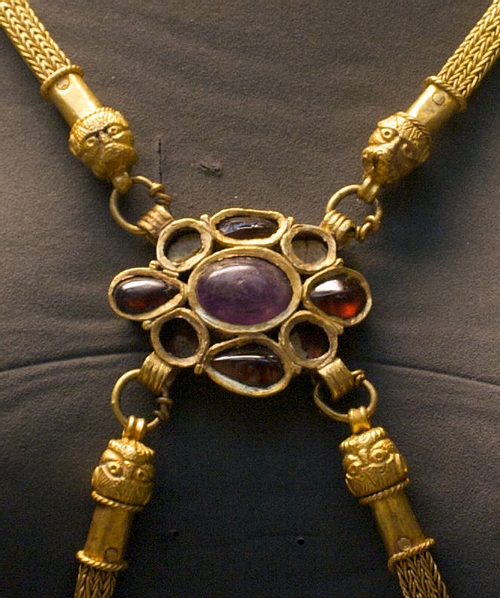
The Context
As with the Staffordshire Hoard there is no evidence for contemporary buildings and certainly no rich Roman villas in the immediate vicinity of the location of the Hoxne Hoard. The closest Roman occupation in the area is at Scole, where a Roman Road known as Pye Road (the modern A140) crosses the River Waveney, about 3.2 km (2 miles) to the north-west of the find spot. 8 km (5 miles) south-west of the location of the Hoxne Hoard there is evidence for a Roman settlement at Stoke Ash, also located on the Pye Road. Both Scole and Stoke Ash have been suggested as the location of the Villa Faustini, a site mentioned in the Antonine Itinerary, a written description began in the 3rd century CE describing the Roman Empire's major roads and stations upon them, which includes 15 routes in Britain. The Villa Faustini was obviously an estate owned by a man named Faustinus, but where exactly it was located and who Faustinus was is unknown.
However, the Hoxne Hoard is not a completely isolated find. In 1781 CE laborers discovered a lead box close to the River Dove in Eye, about 3 km to the south west of Hoxne. The box contained about 600 Roman gold coins dating between the reigns of Valens and Valentinian I (reigned 364–375 CE) and Honorius (393–423 CE). Unfortunately, the coins have long since been scattered amongst various private collectors and are almost impossible to trace. Whether this hoard was related to the Hoxne cache or not it does perhaps suggest something else. Dr. Peter Guest, Senior Lecturer in Roman Archaeology at Cardiff University, and author of The late Roman Gold and Silver Coins from the Hoxne Treasure (see bibliography) has noted the concentration of late Roman hoards in East Anglia and suggests in the book 'an entrenched cultural tradition of deliberately and permanently abandoning precious metal in the ground'. In this hypothesis hoards in the area would have been votive deposits, although Guest has also suggested an alternative theory that argues that the Hoxne hoard was deposited because the objects in it were used as part of a gift-exchange system, which broke down when the Romans left Britain.
Another possibility is that the Hoxne Hoard represents the loot from a robbery, concealed by the thief who was, for whatever reason, unable to return to recover it. However, the simplest explanation for the presence of the Hoxne Hoard is that it was deposited by a wealthy family in an isolated spot for safekeeping after 407 CE in uncertain, even dangerous times as Roman soldiers were departing from Britain. Perhaps the family had to leave Britain in a hurry during this turbulent period, which is why they were not able to retrieve their treasure. Or at least not all of it. Researchers have noted that some common types of Roman jewelery are absent from the hoard, and the types of large silver tableware objects found in the Mildenhall Treasure, which a wealthy Roman family would surely have owned, were also missing. Fabulously rich as it is, the Hoxne Hoard may only represent part of an even greater treasure.


